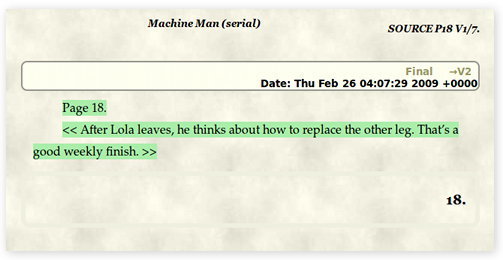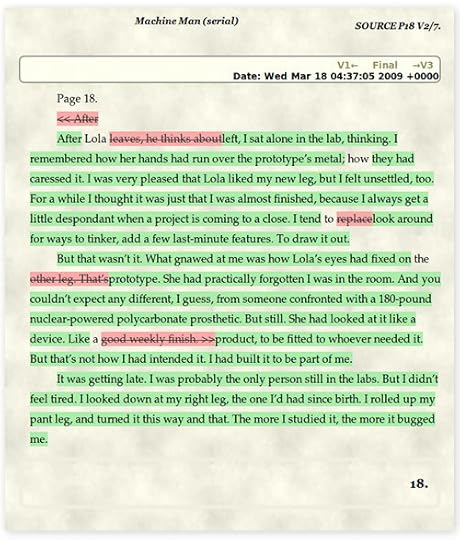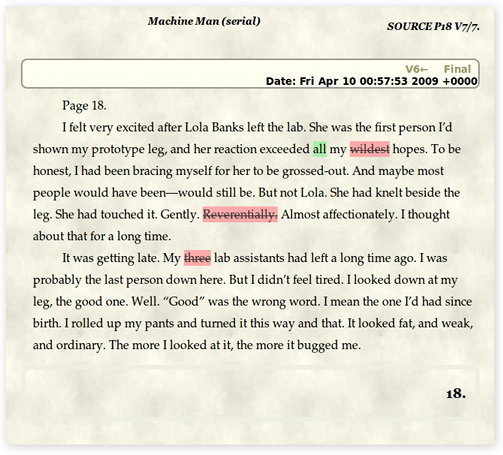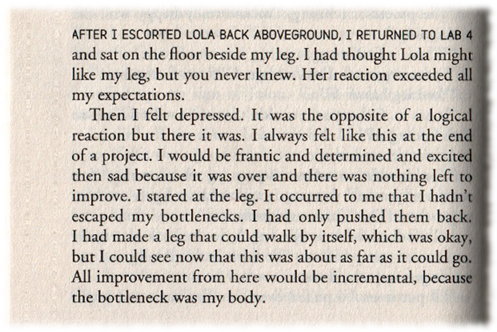I'm a little nervous about this, but here is the nerdiest thing I have ever done.
You realize that bar is already pretty high. I have programmed web games.
I have
considered domain name availability before naming my offspring.
But this is the first time I have publicly released a version control system history
of a book.
I just lost you. I realize that. Unless you are some kind of freako super-geek, in which
case, welcome to the tiny minority of the human race that may appreciate this.
The rest of you: a revision control system is usually used for writing software,
and tracking the changes you make. I used one of these for the
Machine Man serial, since I was uploading a page per day, and it
needed to be processed for sending out to people's email inboxes and cell phones,
and I lost you again, didn't I? Okay.
The point is I have the entire edit history of Machine Man all the way
back from notes. And you can browse to any particular page and see how
it evolved from something to nothing.
Here is an example, using
Version 1 of Page 18:

It's just a note to myself about what this page might be about.
By clicking the
"→V2", you move ahead to
Version 2 of that page:

New words are green, deleted words are red. This page is hard to read because the
software is making bad guesses about how the different versions fit together.
In actuality, I simply deleted my note and wrote a first version.
Then I corrected
a spelling mistake:

And continued tweaking in versions 4 through 9.

The final version is here. And if you have
the book, you can follow along at home to the
version that wound up in the novel:


I'm not sure what use this is to anybody, other than for exposing my writerly
fumblings in an even more humiliating manner than I've already done.
But it was POSSIBLE, so I have DONE IT.
To access the Source version of a page in the Machine Man serial, click
the tiny, near-invisible nut on the top-right of
any serial page. Or append "&v=1" to the
URL, if you're that nerdy. Which, if you've read this far, you surely are.
 newest »
newest »
 newest »
newest »
 Brilliant. I've been trying to design a word processing app for non-trivial documents (books, manuscripts, research papers) with revision (source) control built in. I'd love to hear more about your experiences with your revision system.
Brilliant. I've been trying to design a word processing app for non-trivial documents (books, manuscripts, research papers) with revision (source) control built in. I'd love to hear more about your experiences with your revision system.
 Echoing Rob here — what rcs did you use? One originally designed for software, or is there something out now for prose?
Echoing Rob here — what rcs did you use? One originally designed for software, or is there something out now for prose? I used Subversion, but only because I'm used to it: if I was starting fresh, I'd probably use git.
I used Subversion, but only because I'm used to it: if I was starting fresh, I'd probably use git.










Thanks for sharing, Max. Not a lot of published writers would be willing to publicly dissect their unpolished drafts. I think you did a great thing with 'Machine Man'.